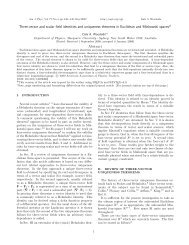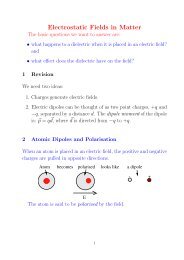Chapter 8 Vector Spaces in Quantum Mechanics
Chapter 8 Vector Spaces in Quantum Mechanics
Chapter 8 Vector Spaces in Quantum Mechanics
Create successful ePaper yourself
Turn your PDF publications into a flip-book with our unique Google optimized e-Paper software.
<strong>Chapter</strong> 8 <strong>Vector</strong> <strong>Spaces</strong> <strong>in</strong> <strong>Quantum</strong> <strong>Mechanics</strong> 82we conclude thatIf we now consider〈±|S 〉 = 〈S |±〉 ∗ . (8.26)〈S ′ | = 〈S ′ |+〉〈+| + 〈S ′ |−〉〈−|and use the result, Eq. (8.26), 〈±|S ′ 〉 = 〈S ′ |±〉 ∗ , we can write this as〈S ′ | = 〈+|S ′ 〉 ∗ 〈+| + 〈−|S ′ 〉 ∗ 〈−| (8.27)or, expressed <strong>in</strong> terms of a ′ = 〈+|S ′ 〉 and b ′ = 〈−|S ′ 〉, we have〈S ′ | = a ′∗ 〈+| + b ′∗ 〈−| (8.28)which has a perfect correspondence with an ord<strong>in</strong>ary vector ˆv ′ <strong>in</strong> the formv ′∗ = a ′∗ û ∗ 1 + b′∗ û ∗ 2 . (8.29)So the bra 〈S ′ | is itself a vector, a bra vector, which can be thought of as be<strong>in</strong>g justthe complex conjugate of the correspond<strong>in</strong>g ket vector |S ′ 〉. But while it is occasionallyuseful to th<strong>in</strong>k this way, it is not strictly true mathematically, and this way of view<strong>in</strong>g a bravector will not be employed here. Instead, as will be shown shortly, an <strong>in</strong>terpretation of ketvectors as column vectors leads to the <strong>in</strong>terpretation of bra vectors as row vectors. A moremathematical standpo<strong>in</strong>t also leads to <strong>in</strong>terpretation of bra vectors as ‘l<strong>in</strong>ear functionals’,that is, a bra is a mathematical operator that acts on a ket vector to produce a complexnumber.F<strong>in</strong>ally, to complete the correspondence, we note that the probability amplitude 〈S ′ |S 〉can be written〈S ′ |S 〉 = a ′∗ a + b ′∗ b (8.30)which can be compared with the <strong>in</strong>ner product v ′∗·v, or written <strong>in</strong> the more formal notation:(v ′ , v) = a ′∗ a + b ′∗ b (8.31)which tells us that the probability amplitude can be considered as be<strong>in</strong>g simply the <strong>in</strong>nerproduct of the two vectors |S ′ 〉 and |S 〉, i.e.〈S ′ |S 〉 = (|S ′ 〉, |S 〉). (8.32)In other words, we have a perfect analogy between the two dimensional complex vectorspace formed by l<strong>in</strong>ear comb<strong>in</strong>ations of the unit vectors û 1 and û 2 discussed <strong>in</strong> Section8.1 and a complex vector space consist<strong>in</strong>g of all the l<strong>in</strong>ear comb<strong>in</strong>ations of the states |±〉.The ket vectors |±〉 are referred to as basis states, analogous to û 1 and û 2 be<strong>in</strong>g referredto as basis vectors.Different sp<strong>in</strong> states can be constructed by form<strong>in</strong>g l<strong>in</strong>ear comb<strong>in</strong>ations |S 〉 = a|+〉 + b|−〉of these basis states, with a and b be<strong>in</strong>g allowed to range over all the complex numbers,though we have only been look<strong>in</strong>g at l<strong>in</strong>ear comb<strong>in</strong>ations with real coefficients. By limit<strong>in</strong>ga and b to be real numbers, we are construct<strong>in</strong>g states whose measured componentof sp<strong>in</strong> all lie <strong>in</strong> the same plane, which, with the system of axes we have been us<strong>in</strong>g here,is the XZ plane. If the coefficients a and b are complex, the state |S 〉 represents a state<strong>in</strong> which the measured component S = S · n is along a direction ˆn that po<strong>in</strong>ts out of this
















